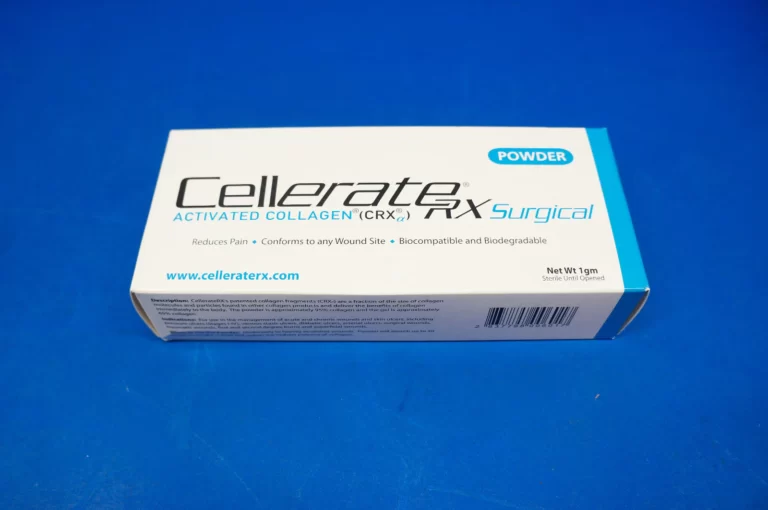Cellerate is a patented collagen-based wound care product used to accelerate healing and support tissue regeneration in a variety of wound types. Available as a powder or gel, it is particularly valued in both hospital and outpatient settings for treating chronic wounds, burns, surgical sites, abrasions, and ulcers. But like many specialized medical products, the price of Cellerate can vary depending on several factors. This article explores the key variables that influence the cost of Cellerate in both clinical and consumer settings, offering insight for providers, patients, and healthcare purchasers alike.
1. Product Formulation and Packaging
One of the most immediate influences on Cellerate pricing is the form in which it is purchased. Cellerate is available primarily as:
- CellerateRX Gel – a hydrolyzed collagen gel that can be applied directly to the wound bed.
- CellerateRX Powder – a collagen powder that is ideal for wounds with moderate to heavy exudate or for use in hard-to-dress areas.
The gel is typically priced higher per unit due to the added components that create its hydrating, spreadable form. In contrast, powder versions may last longer in high-exudate wounds, making them more cost-effective in certain clinical situations. The size of the container (e.g., 3g, 5g, 15g) also affects cost—larger volumes have a higher upfront price, but lower cost per application.
2. Quantity and Frequency of Use
Cellerate is not a one-size-fits-all product. The amount needed depends on wound size, depth, and healing progression. A small, clean surgical incision may require minimal product, while a large diabetic ulcer could demand repeated, generous applications over weeks or months.
Hospitals or long-term care facilities treating chronic wounds may purchase Cellerate in bulk, resulting in a lower per-unit cost. Conversely, individual patients buying out-of-pocket may see higher prices for single-use or small-size packaging.
3. Provider vs. Retail Pricing
Where you purchase Cellerate plays a major role in determining its cost:
- Through Medical Providers: When Cellerate is provided as part of a treatment plan under medical supervision, the cost may be billed to insurance or bundled into the provider’s service fee. Patients may never see the actual product cost directly.
- Retail or Online Purchase: For consumers buying directly through wound care retailers, pharmacies, or online stores, pricing can vary significantly depending on the supplier. Online retailers may offer promotions or discounts, while specialty wound care distributors may charge more due to professional-grade sourcing and expedited delivery.
4. Insurance and Reimbursement Factors
In some cases, Cellerate may be covered by private insurance, Medicare, or Medicaid, especially if prescribed by a licensed medical professional for an eligible wound type. Reimbursement can help offset costs, but not all insurance plans cover every wound care product equally.
Factors that affect coverage include:
- Diagnosis and wound classification
- Medical necessity documentation
- Provider credentials and documentation accuracy
- Patient care setting (inpatient, outpatient, home health)
Out-of-pocket pricing will be higher for uninsured patients or for those whose plans do not cover advanced collagen-based wound treatments.
5. Geographic Location and Supply Chain Costs
Logistics play a role too. Geographic region can affect pricing through variations in:
- State regulations on medical product distribution
- Shipping costs and import duties (for international orders)
- Availability and demand in the local healthcare market
For example, a remote clinic in rural Alaska may face higher product costs due to freight expenses compared to a hospital in a major metropolitan area with direct supplier access.
6. Market Competition and Patented Technology
Cellerate is a proprietary formulation, which means pricing is influenced by intellectual property protections and limited manufacturer competition. While other collagen-based wound care products exist, Cellerate’s specific formulation of hydrolyzed collagen fragments gives it unique properties—such as enhanced absorption and non-immunogenicity—which are often reflected in the price.
Still, healthcare purchasers will often compare Cellerate to alternative brands or generic versions to assess cost-effectiveness, particularly in large-volume healthcare systems.
7. Clinical Outcomes and Value Per Use
While the upfront cost of Cellerate may seem high compared to basic wound dressings, its cost-effectiveness improves when viewed through the lens of long-term outcomes:
- Faster healing reduces the number of dressing changes
- Shortened healing time reduces labor and material costs
- Decreased infection rates and complications prevent costly interventions
In this way, a higher initial product cost may actually result in lower total cost of care, particularly for patients with non-healing or chronic wounds.
The price of Cellerate is shaped by a combination of clinical, economic, and logistical factors—including product type, treatment duration, provider markup, insurance coverage, and market exclusivity. While it may carry a higher price tag than traditional wound dressings, its therapeutic benefits can translate into substantial cost savings over time by improving healing outcomes and reducing complications.
For both patients and healthcare professionals, understanding these variables can help make informed decisions about when and how to incorporate Cellerate into a comprehensive wound care plan.
